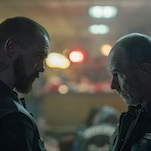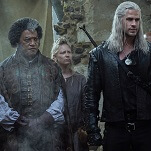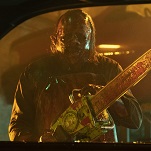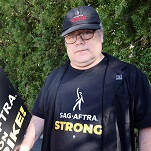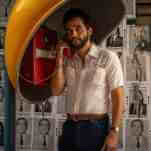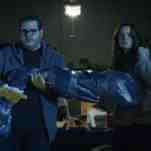Few games have managed to capture the frightening financial strain of the ’00s and beyond quite like Kentucky Route Zero, the heady existential journey through a fantastical American South that has been telling its story since January 2013. It’s the final segment of the game’s third act, though, that best encapsulates its thesis regarding the soullessness of modern labor and the crippling inevitability of debt in today’s world.
Act III opens with Conway, a deliveryman for a failing antiques store and one of our main characters, sitting at a table with his injured leg now a glowing neon orange skeleton. The appendage is revealed in a slow camera pullback, equal parts gorgeous and ominous. There’s little we, as the player and witness here, know about the neon skeleton leg other than Conway’s wish to get his injured leg healed (revealed in the previous act). He comes to in the middle of a conversation with only a snippet available to us: “…but that’s only if you make a late payment on a follow-up visit; I think everything went well enough here and they’ll only want to bill for…” A connection between debts, payments, and the leg are established, another in a bevy of puzzling images that are peppered throughout the game.
More than a mystery to be solved, though, the glowing leg is a harbinger for the events that close out Act III, and the resulting scene is one of the most devastating sequences Kentucky Route Zero has delivered so far. While waiting at a dock for a ferry to arrive, Conway details an encounter he and Shannon had with “the Strangers,” a group they stumbled upon (offscreen) earlier in the game. Shannon and Conway take refuge in an abandoned, burnt-out church. A church pew then reveals itself to be an elevator to an underground whiskey distillery, where every employee shares the skeletal neon glow of Conway’s leg. It becomes clear that the neon skeletons are fully consumed by debts that they’re working to pay off, just as Conway’s leg signals his own debt. What follows after this realization is a flurry of misunderstandings and purposefully misleading language, as Conway is gradually duped into taking a shot of an expensive whiskey—a shot, he’s later told, that he has to work off by becoming a delivery driver for the company.
There’s a reason that the scene is so hauntingly familiar, enhancing the empathy for Conway and his circumstances. The misleading, complex wording used by the workers in the distillery echoes the purposely evasive language heard so often during the 2008 financial crisis—used by banks to sign up disenfranchised families for mortgages they can’t afford or by policymakers to discuss legislation that only supports the wealthiest citizens. Essentially, Conway is left confused and disoriented, and he’s forced to drink the whiskey that brings him into debt. Literally, he’s forced. When Conway is presented with the option of drinking the shot, the game takes over and moves the cursor for you—the only time that happens throughout the first three acts.
As the scene slowly progresses toward its halting conclusion where Conway is strapped with a seemingly lifelong debt, the prevailing feeling is a mix of claustrophobia and outrage. It uncomfortably mimics the current realities of so many Americans who are forced to confront the lack of financial opportunities available to them while trapped inside a cycle of mounting debt. From the start, Kentucky Route Zero has been pleasantly dreamlike, but with the final scene of Act III, it got achingly real.






